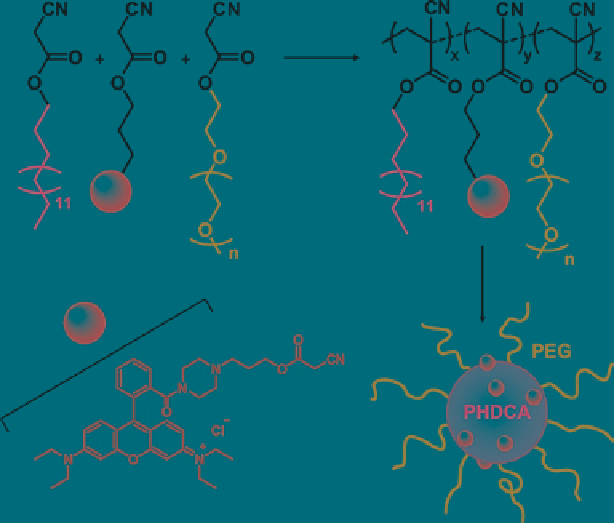Biomedical Engineering Reference
In-Depth Information
which is a drug used to treat HIV infection, was then investigated in order to increase
ddI concentration into the brain and to treat HIV-1 associated dementia (Bourgeois
et al.
2009
; Pierson et al.
2009
).
PECA-
b
-PEG-
b
-PECA amphiphilic triblock copolymer was used to prepare
dexamethasone (DXM)-loaded, PEGylated nanoparticles by the nanoprecipitation
technique (Lin et al.
2008
). Nanoparticles exhibited and average diameter below
100 nm and a high drug loading.
In order to circumvent the drawbacks usually encountered with the use of encap-
sulated fluorescent dyes into nanoparticles (i.e., leakage, burst effect, etc.), fluorescently-
tagged, PEGylated nanoparticles were designed. The strategy was to incorporate the
fluorophore during the synthesis of an amphiphilic PACA copolymer, by tandem
Knoevenagel condensation-Michael addition reaction with HDCA, MePEGCA and
a small amount of a cyanoacetate derivative based on either dansyl or rhodamine B
as the fluorescent dye (Fig.
10
) (Brambilla et al.
2010a
). The resulting fluorescent
nanoparticles showed suitable characteristics for
in vitro
imaging on human brain
endothelial cells and their fluorescence signal was found extremely accurate, as
opposed to a diffuse signal when a lipophilic dye is encapsulated. In addition, it was
recently discovered that these nanoparticles were able to bind the amyloid b-peptide,
a biomarker for Alzheimer's Disease, and to influence its aggregation kinetics
(Brambilla et al.
2010b
).
Fig. 10
Design of fluorescent P(HDCA-
co
-RCA-
co
-MePEGCA) copolymers and nanoparticles
for cell imaging

Search WWH ::

Custom Search